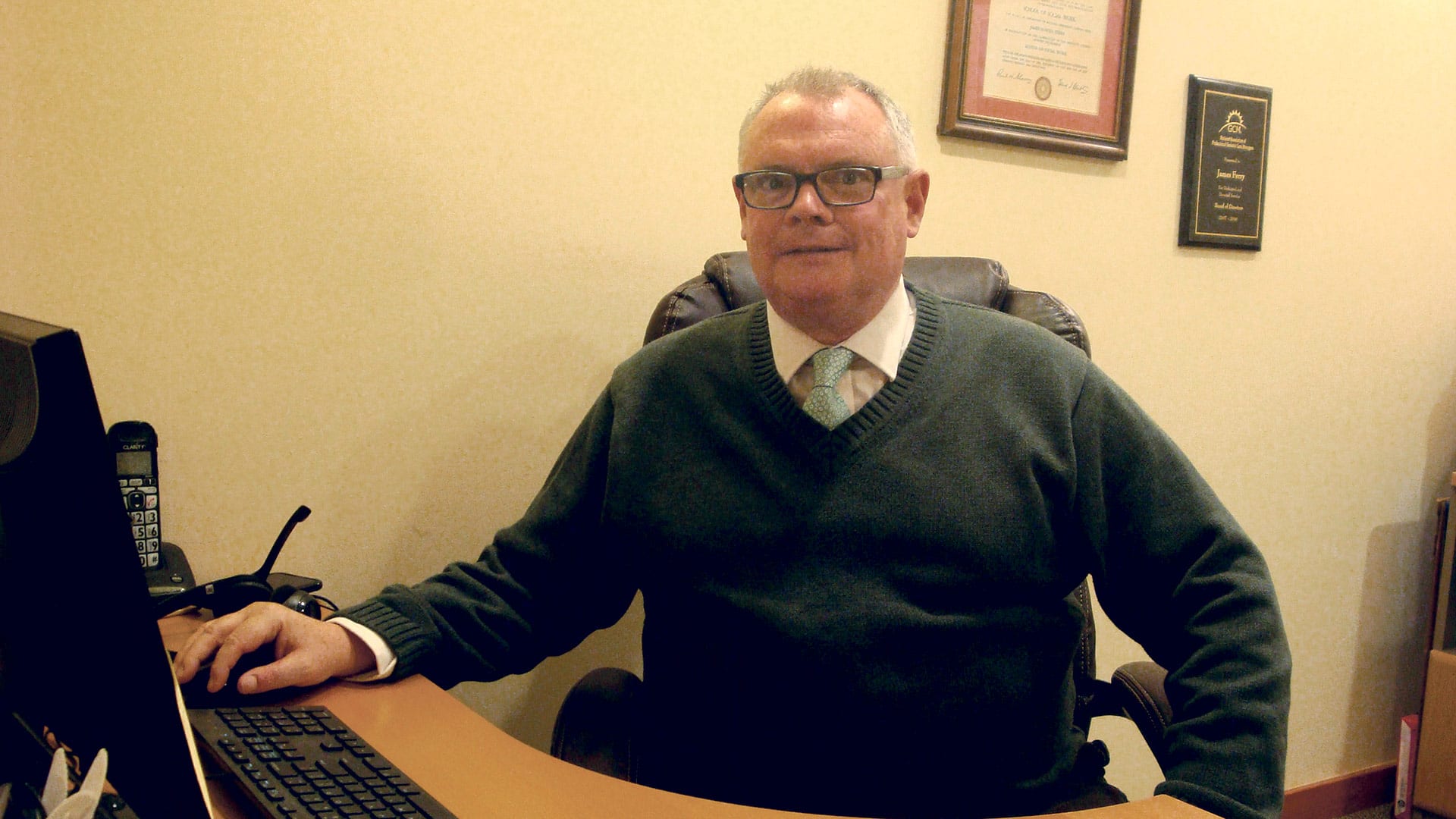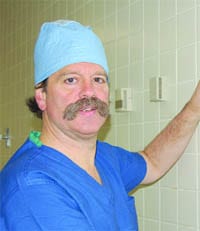Rewards Program – Pediatric Oncologists Confront Cancer on Its Many Levels
When asked why he chose to direct his career toward work in pediatric oncology and hematology, Dr. Matthew Richardson flashed back to his time in medical school at the University of Rochester in New York and the rotations he was going through.
His recollections answered the question quickly and efficiently.
“I always thought I’d be an internist taking care of grownups,” Richardson, interim director of the Pediatric Oncology program at Baystate Medical Center, recalled. “But when I went through the internal-medicine rotation, I really didn’t like it. A lot of the time, the patients wouldn’t get better, and their problems derived from some sort of self-inflicted damage like smoking or drinking too much. But I really didn’t know what I was going to do if I didn’t like internal medicine.”
The next rotation happened to be pediatrics, and there, Richardson found an answer to that question — because he also found just about everything he didn’t find in internal medicine.
“You got to be goofy with the kids or play with the kids,” he told HCN. “And they would get better; they would have illnesses that you would treat, and they would get better. Overall, as I used to say, and still do sometimes, a bad day with kids was still better than a good day with grownups.”
And in pediatric oncology, Richardson would find even more in terms of rewards, challenges, and everything else people get into the healthcare profession for. Indeed, the work involves treating the same patients for several years on average, and guiding them and their families through an experience that will test them in ways they probably couldn’t have imagined — and often to a full recovery and long life.
“When I see a child who’s now a young adult going off to college or in college, and they’re healthy, vibrant, and thriving, it’s incredibly rewarding,” he said.
At the same time, he and others with the Baystate program help introduce new treatment modalities through clinical trials, especially through Baystate’s affiliation with the Children’s Oncology Group, and, in the course of doing so, continue and even accelerate a remarkable pattern of progress that has marked the past several decades and Richardson’s entire career.
Meanwhile, the Baystate program, the only facility of its kind west of Worcester, offers an important level of convenience to patients and their families who would otherwise face of the prospect of battling cancer and having to drive halfway (or all the way) across the state repeatedly as they did so (more on that later).
Amid the many types of rewards and all that progress, however, there are still those times, said Richardson, when he must tell parents that there is nothing more than he can do for their child and that cancer will take their life.
Those conversations are, obviously, extremely difficult, he said, adding quickly that, with advancements made in recent years, there have been fewer of them, and as he looks forward, he is buoyed by the near-certainty that this trend will only continue.
For this issue and its focus on pediatrics, HCN talked at length with Richardson about the state of pediatric oncology, the many of forms of progress being made in this realm, and about why, as he said, a bad day with children beats a good day treating adults.
Talking Points
As he talked with HCN and posed for a few photos in the play deck at Baystate Children’s Hospital, Richardson noted, again, that many of the conversations he has with patients and their families in and around that facility are, indeed, difficult ones.
Starting with the first real talk — the one that comes after a cancer diagnosis.
“Someone’s world has just been completely altered — forever,” he said of the process involved with breaking that news, if you will. “It’s never the same conversation twice because each patient, each family, and each situation is different. Each child and each family deals with the news differently, so you have to be able to read the situation and determine how you think they might best respond to hearing news like that.
Richardson said he has become better at this art and science of ‘reading the situation’ over the years. He attributes this to “many years of learning on the job,” and he said breaking news to patients and families is merely one aspect of a much larger learning process that is ongoing — something else he likes about the specialty he’s chosen.
Richardson is one of three pediatric oncologists in Baystate’s program — actually there are two at the moment because a vacancy is being filled. Together, they see about 30 new patients a year, with almost all them living within 50 miles of the hospital, a catchment area that includes Western Mass., Southern Vermont, Northern Conn., and Eastern New York.
These patients have conditions that cover the full spectrum of pediatric oncology, he went on, adding that this phrase refers to everything from leukemias to brain tumors to kidney, liver, and bone tumors.
The ability to treat such cancers in this region is a huge asset for the region and the families that call it home, he went on, adding this convenience can reduce some layers of stress from situations where there are many.
“When you think about the time, the expense, the hassles, such as parking, parents having to take time off from work, children having to miss time from school … receiving care here is a real blessing,” he said. “A simple 20-minute doctor’s visit can turn into a whole-day affair if you have to go out to Boston, but if you can stay here, you might just have to take the child out of school a little bit early instead of them losing all of most of the day, and that’s important, because many patients have multiple visits every month, and sometimes several days in a row, depending on their treatment.”
And this convenience factor will only be enhanced in a few weeks, when the outpatient pediatric-oncology services currently located at the D’Amour Cancer Center are relocated to space at the Baystate campus on Chestnut Street, just a short elevator ride from the children’s hospital itself.
“It’s beautiful space, and it’s going to bring another level of convenience to patients and their families,” said Richardson.
Progress Report
Returning to his thoughts about why he chose pediatrics and pediatric oncology, Richardson said cancers (or most of them, anyway) are among the few conditions that can actually be cured.
“It’s not like you can take six cycles of hypertension medicine and your high blood pressure goes away,” he noted. “Or you take five cycles of insulin and your diabetes goes away. This [cancer] is a disease that we can treat, and treat successfully.”
And that process of curing children with cancer is extremely rewarding work, he went on, adding that his first experience with this came during his residency (also at the University of Rochester), when he cared for several children with cancer.
“These were kids that you would see over and over again throughout the year as they would come in for treatments, or you would see them in the office,” he explained. “And I liked that continuity, knowing the family when they came and knowing their history.”
Beyond this continuity, Richardson, no doubt speaking for all pediatric oncologists as he did so, said he also enjoys dealing with cancer on the many different levels it must be dealt with.
“Right down to the molecular, genetic level, and what mutation causes cancer,” he explained. “There’s also the cellular level — how does chemotherapy affect the dividing cell? — and the organ level: is this cancer affecting the kidney or the liver?
“And then, it goes to the personal level, and how the child is coping with the diagnosis and the treatment, as well as the family level and how the family is interacting with the healthcare system and dealing with the child’s illness,” he went on. “And if you really want to go the big picture, there’s the societal level, and how we as society try to do research on these rare diseases and come up with the best treatments and how we work together across the country to understand and treat childhood cancers.”
And, as he noted, in recent years, the ability to treat cancer and treat it successfully has only increased.
“It seems that every few years, there’s a new approach and a new modality available that seems to shift the paradigm of how we look at cancers and treat cancers,” he said while offering a quick chronology.
In the ’60s, ’70s, and ’80s, there was basically chemotherapy, which, as he noted, worked “some of the time, but not a lot of the time, and kids would get very sick with them.”
Improvements in chemotherapy coincided with better supportive care — more effective antibiotics and better nutritional support, and improved anti-nausea medications and other developments changed the landscape in the ’90s, he went on, adding that this was a time of what was known as “dose escalation,” because providers could better support children through the side effects.
Over the past 10 to 15 years, antibody therapies, developed to attack specific types of cancer, have become more prevalent, and with tremendous results, he said, adding that, most recently, specialists are taking the patient’s own immune system and training it to fight certain types of cancers.
Such advances have dramatically improved the survival rates for many childhood cancers, including leukemia, said Richardson.
“For some types of leukemia, the cure rate is 90{06cf2b9696b159f874511d23dbc893eb1ac83014175ed30550cfff22781411e5},” he told HCN. “And for a disease that was once uniformly fatal, that’s pretty amazing.”



Comments are closed.